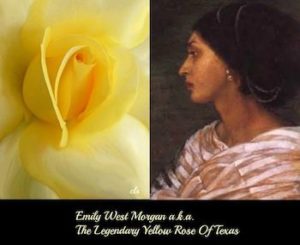
This date in 1830 commemorates the song 'The Yellow Rose of Texas.' On this date annually, the Knights of the Yellow Rose of Texas at San Jacinto, TX, celebrate the song and its history.
Narrations inevitably ask questions about all topics; in this case, who was Yellow Rose? Records say the song's original title was "Emily, the Maid of Morgan's Point." And the story begins in 1830. That year, James Morgan, an entrepreneur and slave owner from Philadelphia, immigrated to Texas. He came to capitalize on the cheap land and business opportunities in the Mexican colony, ultimately becoming Texas. He formed several partnerships with New York speculators, yet Texas did not permit slavery, so Morgan got around the law by converting his slaves into 99-year indentured servants. Morgan returned to New York in 1835 to obtain more workers for his settlement.
One of them was a twenty-year-old woman named Emily D. West, a sophisticated Black eastern slave. West was possibly from Bermuda, and, as was the custom for an indentured worker at the time, she changed her last name to Morgan's. By the following year, in 1836, the war for Texas's independence from Mexico was in full combat. Morgan's now successful settlement, New Washington, was near the mouth of the San Jacinto River. He freely gave his provisions to the Texas cause. One parcel of land named Morgan's Point ran into San Jacinto Bay, where flatboats were loaded with supplies; Emily West Morgan was in charge of loading those flatboats. On April 18, 1836, General Santa Anna approached New Washington, now mostly deserted.
One of those that remained behind, however, was Emily West Morgan. Santa Anna ordered his camp set up on the plains of the San Jacinto despite protests from his colonels who insisted the location violated principles of wartime strategy. Soon, General Sam Houston moved his troops into the woods within a mile of Santa Ana's headquarters. By the afternoon of April 21, the great final battle for the independence of Texas was on, and the Mexican army was caught by surprise. Emily West Morgan survived the battle and returned to New Washington. Two days later, James Morgan, who had not heard of the battle, returned from Galveston, and Emily told him of her ordeal and the outcome of the last great battle.
The colonel was impressed with Emily's heroism; he repealed her indentured status and gave her passage back to New York. Morgan made sure everyone knew of Emily's heroism. He told everyone who would listen and recorded the story in his journals. Morgan "kept a running commentary on Texas affairs with Samuel Swartwout, one of Houston's friends in New York City." He also told his story to an English friend and ethnologist, William Bollaert, who recorded the story in detail. There are accounts from those who were there indicating she did what she could to achieve the independence of Texas.
Today, the heroic acts of the young slave woman from New York are still respectfully commemorated by the members of the Knights of the Yellow Rose of Texas each spring at San Jacinto.
Mark Whitelaw,
Amaranth Publishing 2705 8th Avenue,
Fort Worth, Texas 76110
(817) 921-3670